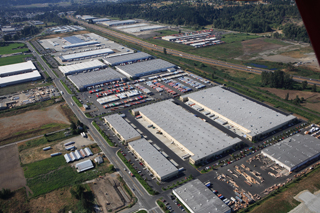
Surveys
DJC.COM
December 10, 2009
Sumner’s industrial market weathers the economic storm
Special to the Journal

Travers
|
At a time when commercial tenants, in any sector, are hard to come by, the Sumner industrial market has attracted more than 500,000 square feet of new tenants in the second half of 2009. An impressive feat that has caught the attentions of brokers, owners and lenders in today’s chilly real estate climate.
The city of Sumner, located in north-central Pierce County and roughly 40 miles south of Seattle and 15 miles east of Tacoma, has four freeway interchanges and access to two major Pacific Coast ports, Seattle and Tacoma. Settled in 1853 by pioneers, the city was built on agriculture. While farming is still strong — Sumner’s known as the “Rhubarb Pie Capital of the World” — the local economy is fueled by food manufacturing, wood products production, and warehousing and distribution.
The Sumner industrial market was established in the mid-1990s as companies were looking for cost-effective alternatives to the Kent Valley. The railroad owned most of what is now the Sumner industrial market, but sold off the surplus land to developers for less than $2 a square foot. Land in Kent at the time was selling for $4-$6 a square foot.

The lower cost of land translated into lower lease rates for tenants and allowed developers to entice companies to move south.
As the Kent Valley market tightened, developers continued to build speculative warehouses in Sumner. Up until the mid-2000s, market absorption averaged 2 million square feet per year throughout the valley, so developers continued to build. As the economy slowed moving into 2008, so did leasing activity. Even today, in Sumner, there are buildings on the market that have been vacant for more than two years.
Brewing up business
Despite its 2009 third-quarter high vacancy rate of 23.4 percent for industrial buildings, Sumner landed Vermont-based Green Mountain Coffee Roasters, a thriving company with approximately 150 local employees. Green Mountain’s expansion plans for the West Coast took off in March, when it bought the Tully’s Coffee brand and wholesale business.
Tully’s roasting plant was in the former iconic Rainier Brewery Building in Seattle — think big “R” along Interstate 5 replaced with big “T.” The T remains, but that fresh coffee aroma is now down in Sumner.

Photo by Matt Todd Photography Sumner is gaining industrial tenants due to its cheaper lease rates, proximity to freeways and ports, and low flood risk. |
In August, Green Mountain committed to moving the Seattle roasting plant to Sumner’s White River Building, owned by developer Investco. The 200,000-square-foot modern facility is more than double Tully’s old space and will be used to roast, package and distribute its award-winning coffees. Green Mountain will invest more than $4 million into the building in the first year alone.
“Sumner’s industrial area is doing very well,” reports Sumner Mayor Dave Enslow. “I’m particularly glad that we’re attracting quality businesses like Green Mountain, Pacific Crest Industries and REI, who are great corporate citizens. These significant employers give South Sound residents an alternative to commuting to Seattle, or even Tacoma. Living and working in the same community, or area, makes a greater impact on reducing our region’s traffic congestion and emissions.”
Sumner commercial and industrial districts support 7,200 jobs.
Dropping vacancies
With the recent activity in the market, industrial vacancy in Sumner is expected to drop in half by midyear 2010, currently at 2.55 million square feet.
“Investco owns almost 20 percent of the Sumner industrial market and has done over 400,000 square feet of leasing in the past six months to get to 100 percent occupancy,” said Edward Turpin, senior vice president at Investco Management Services.
In the case of Green Mountain Coffee, it was a combination of location, amenities and working as a team with the company and Sumner.
“Green Mountain was looking for long-term partners in their real estate needs, both in a landlord and a city. Our local decision-making, financial stability and strong regional ties were a big part of their ultimate decision to choose Investco and Sumner,” Turpin said. “And in an about-face in real estate, they interviewed us and underwrote our financial capabilities as much as we did theirs.”
Unique, to say the least. A tenant reviewing the financial strength of the landlord? The landlord reviewing the financial strength of its bank? It all seems backwards and yet it’s a requirement in today’s financial world. Accountability, through and through, on all sides.
Signing up
Green Mountain, along with REI, Costco, Target, Maersk, Parametrix, Toysmith, Brooks Shoes and J.C. Penney, are examples of quality tenants that have chosen the Sumner market as a viable long-term option for their industrial real-estate needs. Add to the list companies that have recently signed leases including PODS, Owen’s and Minor, Roadrunner Trucking, Pacific Paper and National Oak Distributors. There are several more companies looking at the Sumner market including Unified Grocers, Smurfit, Performance Team, US Merchant, Green Room and LuLuLemon, to name a few.
Costco alone has between 600 and 700 trucks in and out of Sumner daily. The Sumner Costco depot (wholesale/retail stores are “warehouses,” cross-dock shipping operations are “depots”) serves the entire Northwest, a total of 45 warehouses from Alaska to Montana.
When Costco outgrew its previous depot in Auburn in 1999, it purchased 94 acres in Sumner and developed 500,000 square feet with the capacity to double that. With $5 billion worth of goods passing through this facility annually and more than 300 employees, Costco is a loyal Sumner booster.
“Geographically, Sumner is a great spot, we love it. It’s close to commerce hubs Seattle and Portland, has excellent access to inbound ports and interstates and has maintained its small town charm,” said Tom Walker, executive vice-president of Costco construction and distribution.
Sumner also has a few other factors which have contributed to recent activity. It is located next to the White River, which is not fed by the failing Howard Hanson Dam. Howard Hanson Dam feeds the Green River, which runs through the Kent Valley from Auburn to Tukwila. Fear of flooding on the Green River is high.
Sumner also has relatively new distribution space available at rates that haven’t been seen for 10 years. Industrial deals in Sumner are being signed at rates 5 cents to 8 cents less per square foot than those being done in Kent, with one or two months of free rent per year in the leases.
Sumner economics, linked with the lack of threatening floods and ease of logistics, makes a compelling argument that Sumner is high up on the “opportunity meets value” barometer for industrial growth.
Barbara Travers is a Seattle-based writer. She writes for and about the commercial real estate industry.
Other Stories:
- ‘Game changers’ show what’s ahead for commercial real estate
- Need a loan? Here’s what you should know
- Are you prepared for the big flood?
- Aigner finds calm after near-death experience
- 10 things I learned in Green Broker school
- A lean, mean, clean and green future
- Pioneer Square gets ready for change
- New office towers help CBD move north
- Retail’s bumpy ride starts to smooth out
- Is the recession for hotels ready to end?
- Further pain coming in the multifamily markets
- Bellevue’s office market more ‘fit’ than Seattle’s
- Relax; it’s only a business cycle
- Dean C. Allen
- William Pollard
- Chris Pratley
- Why the economic loss rule matters
Copyright ©2009 Seattle Daily Journal and DJC.COM.
Comments? Questions? Contact us.